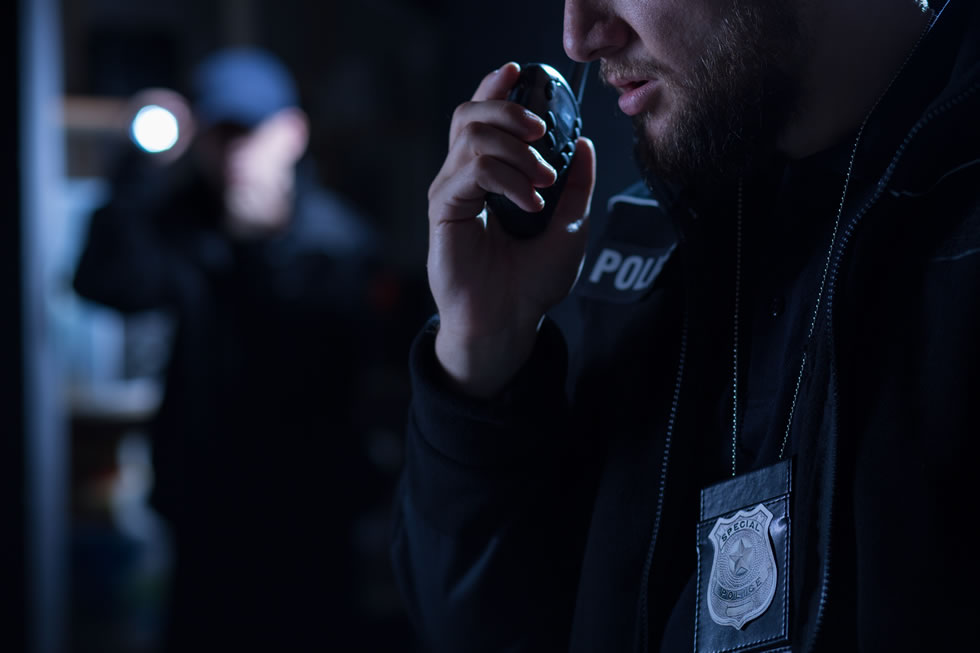It was the late 1990s. My partner and I had a hunch that the vehicle we were following was stolen. So we trailed it for a bit, waiting for the opportunity to justify a legal stop. The driver finally turned left without using his turn signal. As soon as the mars lights illuminated, he hit the gas and sped off. The chase was on.
During those years, it was common knowledge among suspects and criminal justice professionals that if a suspect fled from the police, the chance of him getting a little roughed up for making the police chase him was almost an inevitable conclusion if he was apprehended. In fact, in this particular incident, when we appeared in court, the suspect complained to the judge of being mistreated by the police.
Back in those days, a judge, like most in the criminal justice system, share the same sentiments regarding alleged criminal complaints. The judge stated that if the suspect did not want to get beaten up by the police, then he should consider a different line of work, one that did not involve committing a crime. Times are different today.
Here what was also pervasive at the time: If there were more than two individuals congregating on a corner, those individuals were subject to pat-downs and interrogations. I am not sure what percentage of successful arrests came out of those stop-and-frisks encounters, but it sure cleared street corners, which made our bosses pleased as well as citizens.
The presence of a marked unit approaching made corner congregators quickly start walking away. It was rare for a cop to warn individuals hanging out on a corner to disperse because once the group saw the police coming, they would be halfway down the block by the time the cops arrived.
Were these tactics beneficial in preventing crime? Some critics would say that the group would just move to another location. Thus, the tactic would be futile. But not so fast — during those times, if the group decided to move to another area, those people would most likely be arrested and charged with disorderly conduct, the frequent violation frequently used at the time.
Yes, times have changed in this regard, and unfortunately the changes have not been beneficial to law and order. Yet, some law enforcement officers continue to operate as if they are living in a past era. Many laws have changed, as have many norms — mostly all detrimental for law enforcement officers.
It is clear today that even when a police officer with legal authority orders a citizen to stop an action, any refusal on the citizen’s part is now often viewed by some as an incident in which an untrained officer is escalating a confrontation. In more cases than not, it is the suspect who sets conflicts in motion.
This is like a burglar breaking into a house and then filing a lawsuit after he slips and injures himself while in a commission of a crime. Or when an offender attempts to rob a citizen at gunpoint and things do not turn out the way he figured. Maybe the citizen takes the weapon away and holds the offender until the police arrive. You get the point. The illegal action of a criminal seems to have more validity than that of a law-abiding citizen or a cop.
We are all taught at an early age to respect the law. Refusing to do so has always had consequences regardless of who you are. Then isn’t it logical to surmise that the person who commits a criminal act should be the one who should be held accountable, regardless if he gets hurt during a commission of a crime?
That is a rhetorical question that most people in society understand clearly. We in law enforcement, as well as the majority of law-abiding citizens, know too well that police in our country have never had a more difficult time maintaining law and order. Maybe those judges in the past were not as out of touch with reality when they proclaimed if an individual doesn’t want to get in an altercation with the police, then they should think twice about violating the law.
Today police officers, in many cases, second guess themselves when it comes to using legal force, even when they recognize in their guts that this may be the best course to take. I have heard too many stories from police officers who have become hesitant in using necessary force because of the fear of legal implications. Modern-day police officers must assess the situation as unambiguously as possible not to find themselves in a legal nightmare.
This is from the result of stricter use-of-force policies, mandatory usage of police cameras or the numerous cameras now attached to just about every structure. There are also the camera-obsessive citizens who are always ready to pull out their cell phones to take videos of cops, hoping it will go viral so they can have their five minutes of fame.
Finally, let’s not forget the small but boisterous segments of society who are set on reforming or defunding police departments. It is no wonder that law enforcement continues to be positioned in what appears to be no-win-situations.
Public safety is at the root of the issue regarding the use of force. By definition, deadly force is the use of force that is likely to cause death or severe injury. Prior to 1985, police could use deadly force on fleeing suspects who refused to stop as commanded. Officers before 1985 were also allowed to shoot warning shots if they deemed it necessary. I remember when I was a young officer back in the early 1990s veteran officers sharing their stories on how many times they had shot or had witnessed other officers shoot at fleeing felons. This included property crime offenses.
During that period, many departments allowed officers to use deadly force against fleeing felons who were only suspected of committing crimes. Some jurisdictions did not differentiate between misdemeanors or felonies when using deadly force against a fleeing suspect.
The police justified this practice based on public safety. They argued that if a suspect could escape, they could be a potential danger to the community. Currently this deliberation is still valid. There are countless stories reported about potentially dangerous criminals successfully evading the police only to commit a heinous crime later.
Current laws and police department policies on deadly force stem from the landmark Supreme Court case of Edward Garner. On Oct. 3, 1974, Garner, age 15, and a friend were seen inside a house at night by the next-door neighbor. The neighbor was aware that the house owners were not at home and suspected that there might be a burglary occurring at their neighbor’s house.
A call was made to the police. Two officers from the Memphis Police Department were dispatched. The police arrived at the scene at about a little over 10:45 p.m. As one officer went behind the house, he observed someone running across the yard. He would later say in a statement that he shouted a warning for the person to stop.
The suspect, Garner, tried to make his escape by climbing over a 6-foot-high chain-link fence. The officer who was shining a flashlight was able to see Garner’s face and hands and believed that Garner was unarmed. He also thought that if Garner cleared the fence that he would make good his escape.
The officer understood that he was legally within his rights to use deadly force on a fleeing felon (or a suspected fleeing felon), even if the suspect was unarmed. As Garner’s back was exposed, the officer pulled the trigger, striking Garner in the back of the head. Garner fell and later would die at on operating table at a local hospital. In his possession were $10 and a purse that he had stolen from the house.
Under Tennessee law, the officers were well in their authority to use deadly force. Again, their justification was based on the law at the time allowing cops the legal right to prevent fleeing felons from escaping. At the time, Tennessee and many other states had a law referred to as the Fleeing-Felon Rule, authorizing the use of deadly force to stop any fleeing felon. The shooting of Garner during that period was ruled a justifiable shooting.
The use-of-force issue eventually ended up being decided by the United States Supreme Court in which the majority of opinion the Court justices agreed with the Sixth Circuit Court’s initial determination that apprehension by use of deadly force is a seizure. Thus, the Court must weigh in the nature of the intrusion of the suspect’s Fourth Amendment right.
In Garner, the Supreme Court held, “Unless it is necessary to prevent the escape and the officer has probable cause to believe that the suspect poses a significant threat of death or serious physical injury to the officer or others,” deadly force was no longer allowed. Because using deadly force is considered a seizure, Garner’s court decision enabled the recognition that the Fourth Amendment should be applied to evaluate use-of-force policies.
The Court provided further guidance in Graham v. Connor (1989). Dethorne Graham, who was experiencing a diabetic shock, needed a sugar boost, preferably orange juice, to offset the insulin reaction. He and a friend drove to a convenience store but quickly left because the line was too long.
An officer became suspicious when he observed Graham running out of the store. The two men drove off, but eventually, the officer was able to curb the vehicle. He handcuffed Graham and detained him until it was determined that no crime had occurred. Graham afterward claimed that he suffered injuries during his encounter with the police, which he then officially filed a lawsuit claiming that his Fourth Amendment rights were violated.
The Supreme Court, in this case, replaced the “substantive due process test” of whether the officer acted “in good faith” or “maliciously and sadistically” with a new test — “objective reasonableness.”
The Court held, “The calculus of reasonableness must embody allowance for the fact that police officers are often forced to make split-second judgments in circumstances that are tense, uncertain and rapidly evolving about the amount of force that is necessary for a particular situation.” The reasonableness of force used may be judged, “from the perspective of the officer on the scent rather than with the 20/20 vision of hindsight.”
This is the “lens” through which the courts will view the force incident and evaluate (1) the severity (dangerousness) of the crime at issue, (2) if there is an immediate threat to the officer or others, and (3) whether the suspect is actively resisting or attempting to evade arrest by flight. Elements commonly referred to as the “Graham factors.”
The result of these cases is not that officers cannot use force, but that it must be reasonable under the circumstance when making an arrest. Officers may use force necessary to gain control of an individual.
Federal courts have held that the Constitution does not require officers to use the least amount of force possible in a given situation. It requires that only the force used be reasonable. As you can presume, this language can be ambiguous, which has created debates as judges and lawyers attempt to define reasonableness in many criminal cases throughout the court system.
Consequently, the other question that is always at the forefront regarding the use of force is how much force is acceptable. By law, the police have the authority to use force if necessary to make an arrest, keep the peace or maintain order.
Today this has shown to be more difficult than ever before due to antipolice rhetoric. Many pundits are offering their take on what constitutes acceptable force. Most are ignorant of the role of policing. If judges and lawyers cannot come to a definite answer to reasonableness and acceptable, what makes anyone think that activists and pundits would be successful?
Some antipolice groups have been given the podium by major news outlets to spew inaccurate information to catapult their desired ambitions. This has become an issue since some of these so-called experts and activists have successfully been given an ear to a number of politicians. These politicians instantly voiced their support for whatever point can help them get reelected.
Another more difficult question surrounds where necessary ends and excessive starts. This, too, is a divisive issue that challenges law and order. For a society to understand and respect the concept of law and order, each person must make an effort to understand the conceptualization of their limitless understanding of not only the law but of what it entails to be a law enforcement officer. This is especially imperative when an officer is in the process of protecting society during the commission of a crime.
After Garner v. Tennessee, law enforcement officers abided by the new constitutional law, just like they did when cases such as Miranda v. Arizona and Mapp v. Ohio created new laws. This still applies today and will most definitely be relevant in the future. Contemporary law enforcement officers must operate as if they are being watched 24/7 because many times they are.
There was an old popular television police program, “Hills Street Blues,” based on a fictional, big-city police department. At the start of each episode, the sergeant conducting roll call would remind officers to be “careful out there,” one of the most memorable quotes in TV history. Today leaders should continue using this lexicon but make it reflect current times. “Be careful out there. Everyone is watching you,” would be more appropriate today.
We know change is inevitable, but we in law enforcement also understand that sometimes it is difficult to give up tactics that we deem to have been constructive. I enjoy conversing with fellow retirees and sharing stories about how we used to do police work. The conversation always ends with us sharing a laugh and coming to the conclusion that if we policed the public today as we did back in the old days, we would all be brought up on charges.
But I have to remind myself and my fellow retirees that when we got on the job, we had to adapt as well. Cases such as Whren v. U.S. (making traffic stops), McDonald v. City of Chicago (right to have a handgun in the home) and U.S. v. Arvizu (reasonable suspicion) are some of the cases that changed policing during our era. Every police generation will have to adapt to the changes in society. My generation was able to adapt and thrive as well as the previous generations. There is no doubt in my mind that current law enforcement and future law enforcement officers will be just as successful.
Use of Force summary
1. Places sanctity of human life at the center of police
2. Emphasizes overall goal of seeking voluntary compliance
3. Describes a standard for assessing uses of force in plain English, minimizes legalese and case citations
4. Standard is based on reasonable officer on the scent, not 20/20 hindsight
5. Emphasizes the difficulty of split-second officer decision-making
6. Highlights officer safety concerns: no requirement that officers take actions that create a danger to themselves
7. Objectively reasonable
8. Necessary
9. Proportional
10. Bars use of excessive force, discriminatory force, force as punishment or retaliation, and force in response to exercise of First Amendment rights
11. Limits use of deadly force on fleeing felons — requires the existence of an imminent threat, which exists when:
12. Subject’s actions are immediately likely to cause death or great bodily harm;
13. Subject has means or instruments to cause death or great bodily harm;
14. The subject has the opportunity and ability to cause death or great physical harm.
15. Deadly force may only be used as a last resort
16. Defines uses of force that constitute deadly force
17. Includes intentional head strikes with impact weapon and chokeholds
(Source Chicago Police Use of Force Policy, G03-02)





